Forecasting Urban Sprawl Dynamics in Islamabad: A Neural Network Approach
Abstract
:1. Introduction
2. Materials and Methods
2.1. Study Area
2.2. Data Acquisition
2.3. Spectral Indices for Sustainability Assessment and Accuracy
2.4. Support Vector Machine
2.5. Transition Potential Modeling and Driving Factor Selection
2.5.1. Transition Potential
2.5.2. Selection of Explanatory Variables
2.5.3. Multilayer Perceptron
2.6. Future LULC Mapping and Change Analysis
2.6.1. Markov Chain Model
2.6.2. Model Validation
2.7. Landscape Metrics
3. Results
3.1. Spatiotemporal Distribution of LULC Types in Islamabad (2000–2020)
3.2. LULC Inter-Category Transition in Islamabad (2000–2020)
3.3. Accuracy Assessment for the Years 2000–2020
3.4. Land Cover Changes in Built-Up and Non-Built-Up Areas (2000–2020)
3.5. Persistence and Vulnerability of LULC Class Dynamics in Islamabad
3.6. Future Simulation
Selection of Driving Variables for Transition Potential Modeling
3.7. Model Validation Results
3.8. Future Simulation/Scenario
Future Simulation Gain, Loss, and Net Change
3.9. Landscape Metrics Analysis
3.9.1. Change in Spatial Composition of the Landscape (Landscape Level)
3.9.2. Change in Spatial Composition of the Landscape (Class Level)
4. Discussion
4.1. Urbanization and Growth Patterns
4.2. Urban Growth Factors
4.3. Socio-Economic Sustainability
5. Conclusions
Author Contributions
Funding
Data Availability Statement
Acknowledgments
Conflicts of Interest
Appendix A
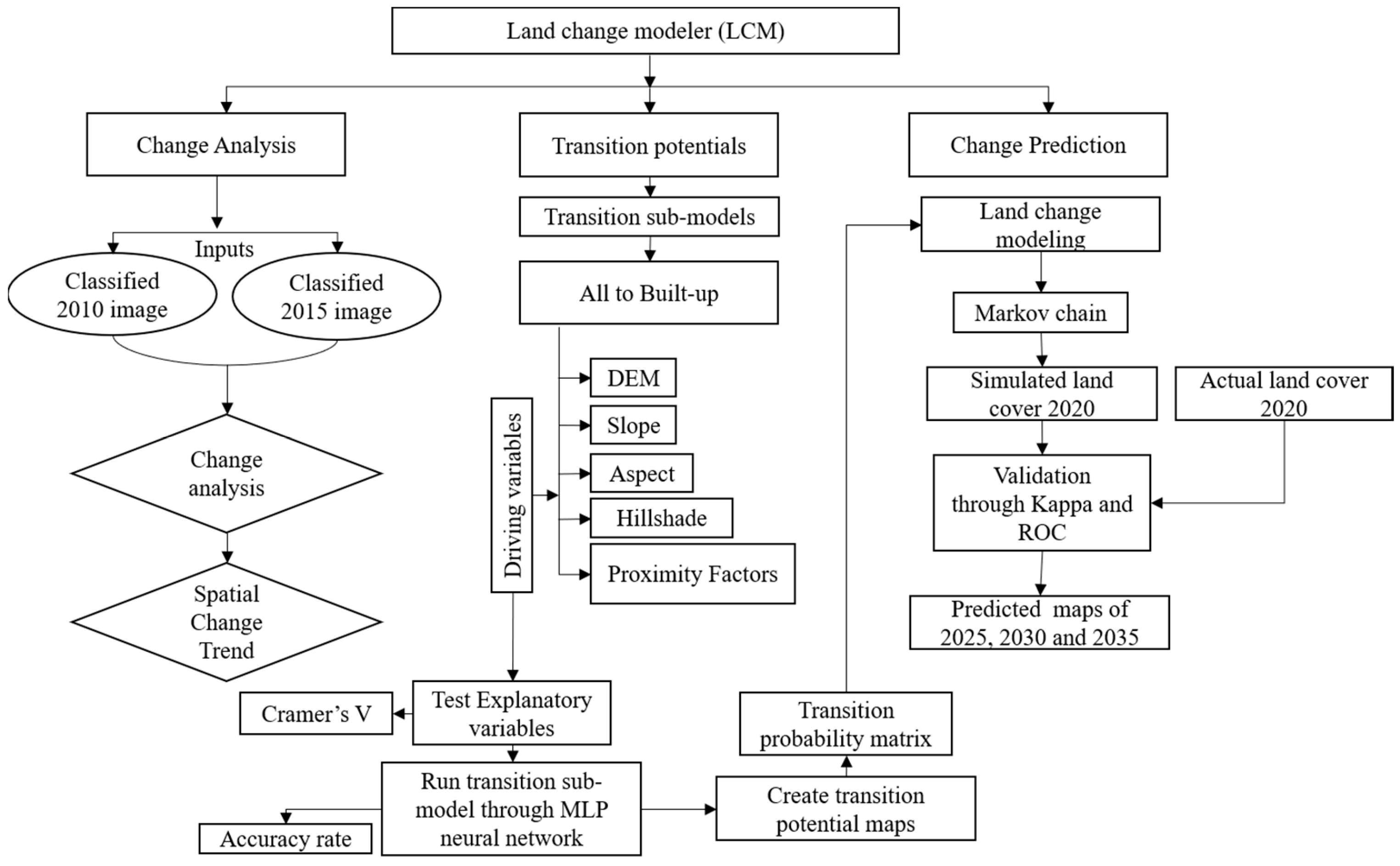
References
- Rimal, B.; Zhang, L.; Keshtkar, H.; Haack, B.; Rijal, S.; Zhang, P. Land Use/Land Cover Dynamics and Modeling of Urban Land Expansion by the Integration of Cellular Automata and Markov Chain. ISPRS Int. J. Geo-Inf. 2018, 7, 154. [Google Scholar] [CrossRef]
- Khawaldah, H.A.; Farhan, I.; Alzboun, N.M. Simulation and prediction of land use and land cover change using GIS, remote sensing and CA-Markov model. Glob. J. Environ. Sci. Manag. 2020, 6, 215–232. [Google Scholar] [CrossRef]
- Sukmawati, D.P.; Simorangkir, J.A.; Juniati, R.; Rahmad, A.S. Assessing Land Cover Change Projections and Its Suitability with Urban Spatial Pattern Plan Using Google Earth Engine and Cellular Automata in the National Activity Centres on Sumatera Island. IOP Conf. Ser. Earth Environ. Sci. 2023, 1264, 012009. [Google Scholar] [CrossRef]
- Saddique, N.; Mahmood, T.; Bernhofer, C. Quantifying the impacts of land use/land cover change on the water balance in the afforested River Basin, Pakistan. Environ. Earth Sci. 2020, 79, 448. [Google Scholar] [CrossRef]
- Islam, I.; Tonny, K.F.; Hoque, M.Z.; Abdullah, H.M.; Khan, B.M.; Islam, K.H.S.; Prodhan, F.A.; Ahmed, M.; Mohana, N.T.; Ferdush, J. Monitoring and prediction of land use land cover change of Chittagong Metropolitan City by CA-ANN model. Int. J. Environ. Sci. Technol. 2024, 21, 6275–6286. [Google Scholar] [CrossRef]
- Wang, L.; Li, C.C.; Ying, Q.; Cheng, X.; Wang, X.Y.; Li, X.Y.; Hu, L.Y.; Liang, L.; Yu, L.; Huang, H.B.; et al. China’s urban expansion from 1990 to 2010 determined with satellite remote sensing. Chinese Sci. Bull. 2012, 57, 2802–2812. [Google Scholar] [CrossRef]
- Maimaitijiang, M.; Ghulama, A.; Onésimo Sandoval, J.S.; Maimaitiyiming, M. Drivers of land cover and land use changes in St. Louis metropolitanarea over the past 40 years characterized by remote sensing andcensus population data. Int. J. Appl. Earth Obs. Geoinf. 2015, 35, 161–174. [Google Scholar] [CrossRef]
- Zhang, X.; Zhou, J.; Song, W. Simulating urban sprawl in china based on the artificial neural network-cellular Automata-Markov model. Sustainability 2020, 12, 4341. [Google Scholar] [CrossRef]
- Wang, R.; Murayama, Y. Change of Land Use/Cover in Tianjin City Based on the Markov and Cellular Automata Models. ISPRS Int. J. Geo Inf. 2017, 6, 150. [Google Scholar] [CrossRef]
- Gilani, H.; Ahmad, S.; Qazi, W.A.; Abubakar, S.M.; Khalid, M. Monitoring of urban landscape ecology dynamics of Islamabad capital territory (ICT), Pakistan, over four decades (1976–2016). Land 2020, 9, 123. [Google Scholar] [CrossRef]
- Development Bank. Pakistan National Urban Assessment; Development Bank: Manila, Philippines, 2024; ISBN 9789292708252. [Google Scholar]
- Government of Pakistan. Population, Labour Force & Employment. In Pakistan Economic Survey 2017–18; Finance Division, Government of Pakistan: Islamabad, Pakistan, 2018; p. 10. [Google Scholar]
- Kreutzmann, H. Islamabad–Living with the Plan. South Asia Chron. 2013, 3, 135–160. [Google Scholar]
- Saputra, M.H.; Lee, H.S. Prediction of land use and land cover changes for North Sumatra, Indonesia, using an artificial-neural-network-based cellular automaton. Sustainability 2019, 11, 3024. [Google Scholar] [CrossRef]
- Hasan, S.; Shi, W.; Zhu, X.; Abbas, S.; Khan, H.U.A. Future Simulation of Land Use Changes in Rapidly Urbanizing South China Based on Land Change Modeler and Remote Sensing Data. Sustainability 2020, 12, 4350. [Google Scholar] [CrossRef]
- Yang, C.; Li, Q.; Zhao, T.; Liu, H.; Gao, W.; Shi, T.; Guan, M.; Wu, G. Detecting spatiotemporal features and rationalities of urban expansions within the Guangdong-Hong Kong-Macau Greater Bay Area of China from 1987 to 2017 using time-series Landsat images and socioeconomic data. Remote Sens. 2019, 11, 2215. [Google Scholar] [CrossRef]
- Bhattacharya, R.K.; Das Chatterjee, N.; Das, K. Land use and land cover change and its resultant erosion susceptible level: An appraisal using RUSLE and Logistic Regression in a tropical plateau basin of West Bengal, India. Environ. Dev. Sustain. 2021, 23, 1411–1446. [Google Scholar] [CrossRef]
- Schumann, G.J.P.; Brakenridge, G.R.; Kettner, A.J.; Kashif, R.; Niebuhr, E. Assisting flood disaster response with earth observation data and products: A critical assessment. Remote Sens. 2018, 10, 1230. [Google Scholar] [CrossRef]
- Chisanga, C.B.; Phiri, D.; Mubanga, K.H. Multi-decade land cover/land use dynamics and future predictions for Zambia: 2000–2030. Discov. Environ. 2024, 2, 38. [Google Scholar] [CrossRef]
- Qamer, F.M.; Shehzad, K.; Abbas, S.; Murthy, M.S.R.; Xi, C.; Gilani, H.; Bajracharya, B. Mapping deforestation and forest degradation patterns in Western Himalaya, Pakistan. Remote Sens. 2016, 8, 385. [Google Scholar] [CrossRef]
- Taloor, A.K.; Sharma, S.; Parsad, G.; Jasrotia, R. Land use land cover simulations using integrated CA-Markov model in the Tawi Basin of Jammu and Kashmir India. Geosyst. Geoenviron. 2024, 3, 100268. [Google Scholar] [CrossRef]
- Usman, H.; Khan, A. Application of Remote Sensing and GIS in Forest Cover Change in District Haripur, Pakistan. J. Remote Sens. GIS 2021, 10, 1–6. [Google Scholar]
- Salih, A.A.M.; Ganawa, E.-T.; Elmahl, A.A. Spectral mixture analysis (SMA) and change vector analysis (CVA) methods for monitoring and mapping land degradation/desertification in arid and semiarid areas (Sudan), using Landsat imagery. Egypt. J. Remote Sens. Sp. Sci. 2017, 20, S21–S29. [Google Scholar] [CrossRef]
- Hasan, L. The Islamabad Master Plan. Pak. Dev. Rev. 2020, 61, 501–509. [Google Scholar] [CrossRef]
- Tasser, E.; Leitinger, G.; Tappeiner, U. Climate change versus land-use change—What affects the mountain landscapes more? Land Use Policy 2017, 60, 60–72. [Google Scholar] [CrossRef]
- Farhan, M.; Wu, T.; Anwar, S.; Yang, J.; Naqvi, S.A.A.; Soufan, W.; Tariq, A. Predicting Land Use Land Cover Dynamics and Land Surface Temperature Changes Using CA-Markov-Chain Models in Islamabad, Pakistan (1992–2042). IEEE J. Sel. Top. Appl. Earth Obs. Remote Sens. 2024, 17, 16255–16271. [Google Scholar] [CrossRef]
- Roy, H.G.; Fox, D.M.; Emsellem, K. Predicting Land Cover Change in a Mediterranean Catchment at Different Time Scales. Comput. Sci. Its Appl. ICCSA 2014 2014, 8582, 315–330. [Google Scholar]
- Singh, S.K.; Mustak, S.; Srivastava, P.K.; Szabó, S.; Islam, T. Predicting Spatial and Decadal LULC Changes Through Cellular Automata Markov Chain Models Using Earth Observation Datasets and Geo-information. Environ. Process. 2015, 2, 61–78. [Google Scholar] [CrossRef]
- Kumar, K.; Sundara, D.P.; Udaya Bhaskar, D.K.P. Application of Land Change Modeller For Prediction of future Land Use Land Cover A Case Study of Vijayawada City. Int. J. Adv. Technol. Eng. Sci. 2015, 3, 773–783. [Google Scholar]
- Wang, J.; Maduako, I.N. Spatio-temporal urban growth dynamics of Lagos Metropolitan Region of Nigeria based on Hybrid methods for LULC modeling and prediction. Eur. J. Remote Sens. 2018, 51, 251–265. [Google Scholar] [CrossRef]
- Mishra, V.; Rai, P.; Mohan, K. Prediction of land use changes based on land change modeler (LCM) using remote sensing: A case study of Muzaffarpur (Bihar), India. J. Geogr. Inst. Jovan Cvijic, SASA 2014, 64, 111–127. [Google Scholar] [CrossRef]
- Tewolde, M.G.; Cabral, P. Urban sprawl analysis and modeling in Asmara, Eritrea. Remote Sens. 2011, 3, 2148–2165. [Google Scholar] [CrossRef]
- Zhang, J.; Liu, L. Neural Cellular Automata-based Land Use Changes Simulation. Int. Arch. Photogramm. Remote Sens. Spat. Inf. Sci. ISPRS Arch. 2024, 48, 843–848. [Google Scholar] [CrossRef]
- Wu, K.Y.; Ye, X.Y.; Qi, Z.F.; Zhang, H. Impacts of land use/land cover change and socioeconomic development on regional ecosystem services: The case of fast-growing Hangzhou metropolitan area, China. Cities 2013, 31, 276–284. [Google Scholar] [CrossRef]
- Barnsley, M.J.; Barr, S.L. Inferring urban land use from satellite sensor images using Kernel-based spatial reclassification. Photogramm. Eng. Remote Sens. 1996, 62, 949–958. [Google Scholar]
- Pelorosso, R.; Leone, A.; Boccia, L. Land cover and land use change in the Italian central Apennines: A comparison of assessment methods. Appl. Geogr. 2009, 29, 35–48. [Google Scholar] [CrossRef]
- Aithal, B.H.; Vinay, S.; Ramachandra, T. V Prediction of Land use Dynamics in the Rapidly Urbanising Landscape using Land Change Modeller. In Proceedings of the International Conference on Advances in Computer Sciences, AETACS, Delhi, India, 13–14 December 2013; pp. 1–11. [Google Scholar]
- Ministry of NHSR&C Islamabad Capital Territory Health Strategy 2019-23 MoNHSRC 2018.pdf 2018. Available online: https://www.nhsrc.gov.pk/ (accessed on 1 November 2024).
- Bokhari, S.A.; Saqib, Z.; Ali, A.; Haq, M.Z. Perception of Residents about Urban Vegetation: A Comparative Study of Planned Versus Semi-Planned Cities of Islamabad and Rawalpindi, Pakistan. J. Ecosyst. Ecography 2018, 8, 2. [Google Scholar] [CrossRef]
- Batool, R.; Javaid, K. Spatio-temporal assessment of Margalla hills forest by using LANDSAT imagery for year 2000 and 2018. Int. Arch. Photogramm. Remote Sens. Spat. Inf. Sci. ISPRS Arch. 2018, 42, 69–72. [Google Scholar] [CrossRef]
- Butt, M.J.; Waqas, A.; Iqbal, M.F.; Muhammad, G.; Lodhi, M.A.K. Assessment of Urban Sprawl of Islamabad Metropolitan Area Using Multi-Sensor and Multi-Temporal Satellite Data. Arab. J. Sci. Eng. 2012, 37, 101–114. [Google Scholar] [CrossRef]
- Kamran; Khan, J.A.; Khayyam, U.; Waheed, A.; Khokhar, M.F. Exploring the nexus between land use land cover (LULC) changes and population growth in a planned city of Islamabad and unplanned city of Rawalpindi, Pakistan. Heliyon 2023, 9, e13297. [Google Scholar] [CrossRef]
- Abbas, H.; Tao, W.; Khan, G.; Alrefaei, A.F.; Iqbal, J.; Albeshr, M.F.; Kulsoom, I. Multilayer perceptron and Markov Chain analysis based hybrid-approach for predicting land use land cover change dynamics with Sentinel-2 imagery. Geocarto Int. 2023, 38, 2256297. [Google Scholar] [CrossRef]
- Liu, Y.; Jiang, Y. Urban growth sustainability of Islamabad, Pakistan, over the last 3 decades: A perspective based on object-based backdating change detection. GeoJournal 2020, 86, 2035–2055. [Google Scholar] [CrossRef]
- Pizaña, J.M.G.; Hernández, J.M.N.; Romero, N.C. Remote Sensing-Based Biomass Estimation. In Environmental Applications of Remote Sensing; Marghany, M., Ed.; IntechOpen Limited: London, UK, 2016. [Google Scholar]
- Duda, R.O.; Hart, P.E.; Stork, D.G.; Wiley, J. Pattern Classification, 2nd ed.; John Wiley & Sons, Inc.: New York, NY, USA, 2002. [Google Scholar]
- Candade, N.; Dixon, D.B. Multispectral Classification of Landsat Images: A Comparison of Support Vector Machine and Neural Network Classifiers. In Proceedings of the ASPRS Annual Conference Proceeding, Denver, CO, USA, 23–28 May 2004; p. 12. [Google Scholar]
- Halder, S.; Das, S.; Basu, S. Use of support vector machine and cellular automata methods to evaluate impact of irrigation project on LULC. Environ. Monit. Assess. 2023, 195, 3. [Google Scholar] [CrossRef] [PubMed]
- Talukdar, S.; Singha, P.; Mahato, S.; Shahfahad; Pal, S.; Liou, Y.A.; Rahman, A. Land-use land-cover classification by machine learning classifiers for satellite observations-A review. Remote Sens. 2020, 12, 1135. [Google Scholar] [CrossRef]
- Li, Q.; Qin, Y.; Wang, Z.; Zhao, Z.; Zhan, M.; Liu, Y.; Li, Z. The Research of Urban Rail Transit Sectional Passenger Flow Prediction Method. J. Intell. Learn. Syst. Appl. 2013, 2013, 227–231. [Google Scholar] [CrossRef]
- Wu, B.; Zhang, L.; Zhao, Y. Feature selection via Cramer’s V-test discretization for remote-sensing image classification. IEEE Trans. Geosci. Remote Sens. 2013, 52, 2593–2606. [Google Scholar] [CrossRef]
- Verburg, P.H.; Overmars, K.P. Combining top-down and bottom-up dynamics in land use modeling: Exploring the future of abandoned farmlands in Europe with the Dyna-CLUE model. Landsc. Ecol. 2009, 24, 1167–1181. [Google Scholar] [CrossRef]
- Hamad, R.; Balzter, H.; Kolo, K. Predicting land use/land cover changes using a CA-Markov model under two different scenarios. Sustainability 2018, 10, 3421. [Google Scholar] [CrossRef]
- Mohsen, D.; Helmi, Z.M.S.; Noordin, A.; Biswajeet, P.S.S. Land Use/Cover Change Detection and Urban Sprawl Analysis in Bandar Abbas City, Iran Information | Open Access Article | openaccessarticles.com. Sci. World J. 2014, 2014, 12. [Google Scholar]
- Selmy, S.A.H.; Kucher, D.E.; Mozgeris, G.; Moursy, A.R.A.; Jimenez-Ballesta, R.; Kucher, O.D.; Fadl, M.E.; Mustafa, A.R.A. Detecting, Analyzing, and Predicting Land Use/Land Cover (LULC) Changes in Arid Regions Using Landsat Images, CA-Markov Hybrid Model, and GIS Techniques. Remote Sens. 2023, 15, 5522. [Google Scholar] [CrossRef]
- Voight, C.; Hernandez-Aguilar, K.; Garcia, C.; Gutierrez, S. Predictive modeling of future forest cover change patterns in southern Belize. Remote Sens. 2019, 11, 823. [Google Scholar] [CrossRef]
- Özyavuz, M.; Onur, Ş.; Bilgili, B.C. A change vector analysis technique to monitor land-use/land-cover in the yildiz Mountains, Turkey. Fresenius Environ. Bull. 2011, 20, 1190–1199. [Google Scholar]
- Eastman, J.R.; Fossen, M.E.V.; Solarzano, L.A. Transition Potential Modeling for Land-Cover Change. GIS, Spatial Analysis, and Modeling; Maguire, D.J., Batty, M., Goodchild, M.F., Eds.; ESRI Press: Redlands, CA, USA, 2005. [Google Scholar]
- Mohammady, S.; Delavar, M.R.; Pahlavani, P. Urban Growth Modeling Using an Artificial Neural Network a Case Study of Sanandaj City, Iran. ISPRS Int. Arch. Photogramm. Remote Sens. Spat. Inf. Sci. 2014, XL-2/W3, 203–208. [Google Scholar] [CrossRef]
- Choudhury, U.; Singh, S.K.; Kumar, A.; Meraj, G.; Kumar, P.; Kanga, S. Assessing Land Use/Land Cover Changes and Urban Heat Island Intensification: A Case Study of Kamrup Metropolitan District, Northeast India (2000–2032). Earth 2023, 4, 503–521. [Google Scholar] [CrossRef]
- Mohammady, S.; Delavar, M.R. Urban sprawl assessment and modeling using landsat images and GIS. Model. Earth Syst. Environ. 2016, 2, 155. [Google Scholar] [CrossRef]
- Lin, Y.-P.; Lin, Y.-B.; Wang, Y.-T.; Hong, N.-M. Monitoring and Predicting Land-use Changes and the Hydrology of the Urbanized Paochiao Watershed in Taiwan Using Remote Sensing Data, Urban Growth Models and a Hydrological Model. Sensors 2008, 8, 658–680. [Google Scholar] [CrossRef] [PubMed]
- Deng, J.; Desjardins, M.R.; Delmelle, E.M. An interactive platform for the analysis of landscape patterns: A cloud-based parallel approach. Ann. GIS 2019, 25, 99–111. [Google Scholar] [CrossRef]
- Zhou, W.; Wang, J.; Cadenasso, M.L. Effects of the spatial configuration of trees on urban heat mitigation: A comparative study. Remote Sens. Environ. 2017, 195, 1–12. [Google Scholar] [CrossRef]
- Wang, X.; Blanchet, F.G.; Koper, N. Measuring habitat fragmentation: An evaluation of landscape pattern metrics. Methods Ecol. Evol. 2014, 5, 634–646. [Google Scholar] [CrossRef]
- Hargis, C.D.; Bissonette, J.A.; David, J.L. The behavior of landscape metrics commonly used in the study of habitat fragmentation. Landsc. Ecol. 1998, 13, 167–186. [Google Scholar] [CrossRef]
- Dewan, A.M.; Corner, R.J. Spatiotemporal Analysis of Urban Growth, Sprawl and Structure. In Dhaka Megacity; Dewan, A., Corner, R., Eds.; Springer: Dordrecht, The Netherlands, 2014; pp. 99–121. ISBN 978-94-007-6735-5. [Google Scholar]
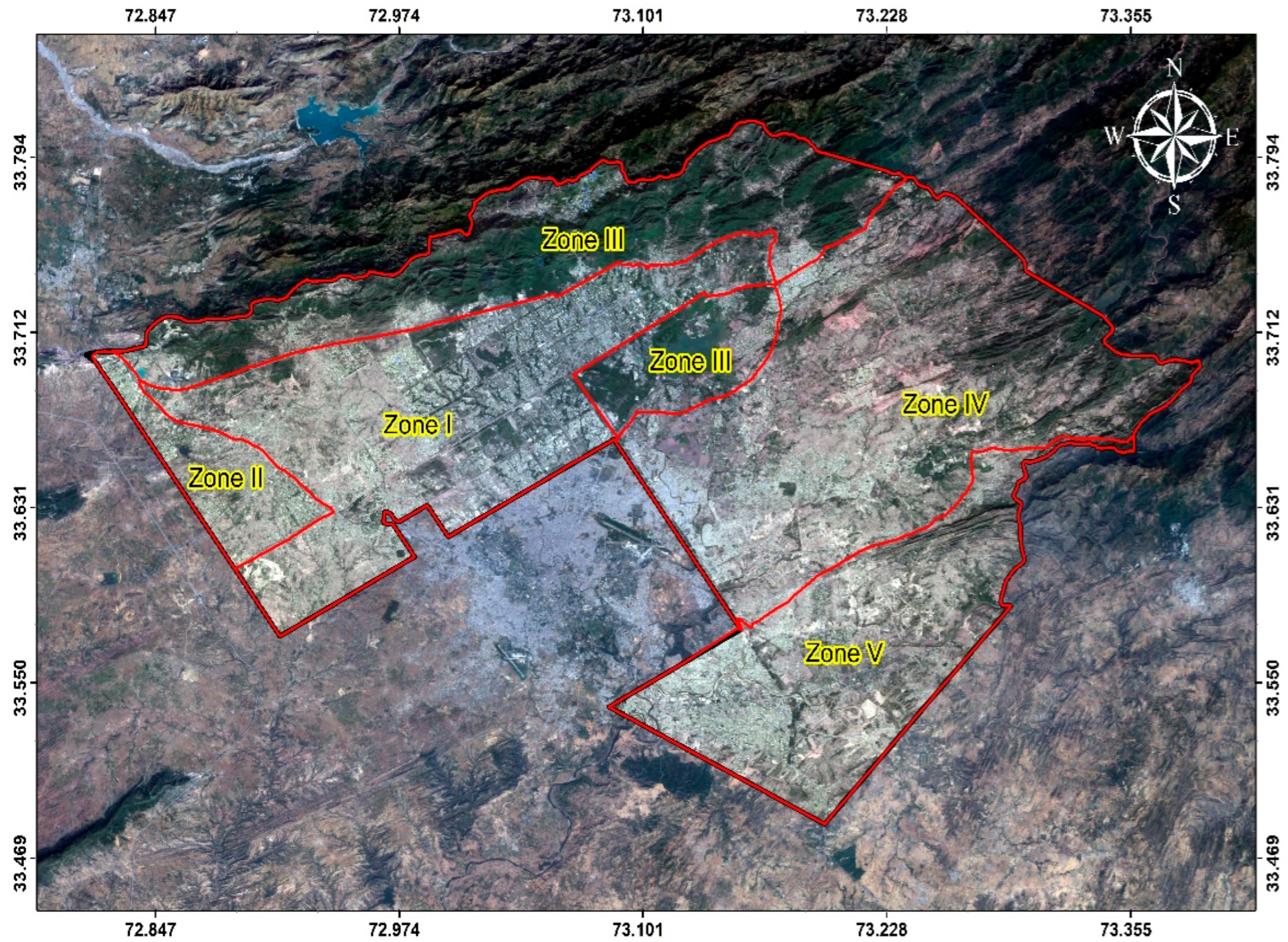
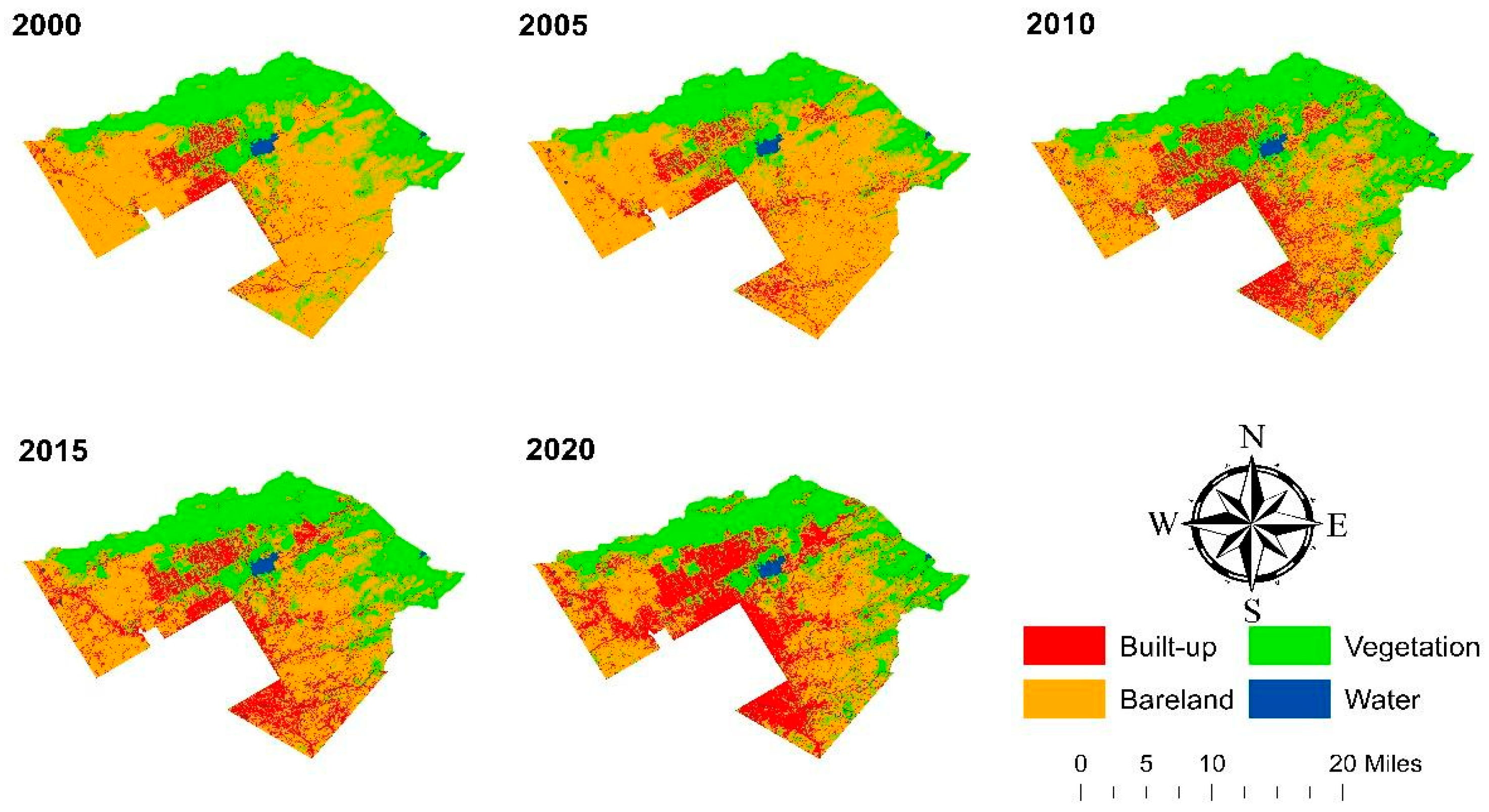

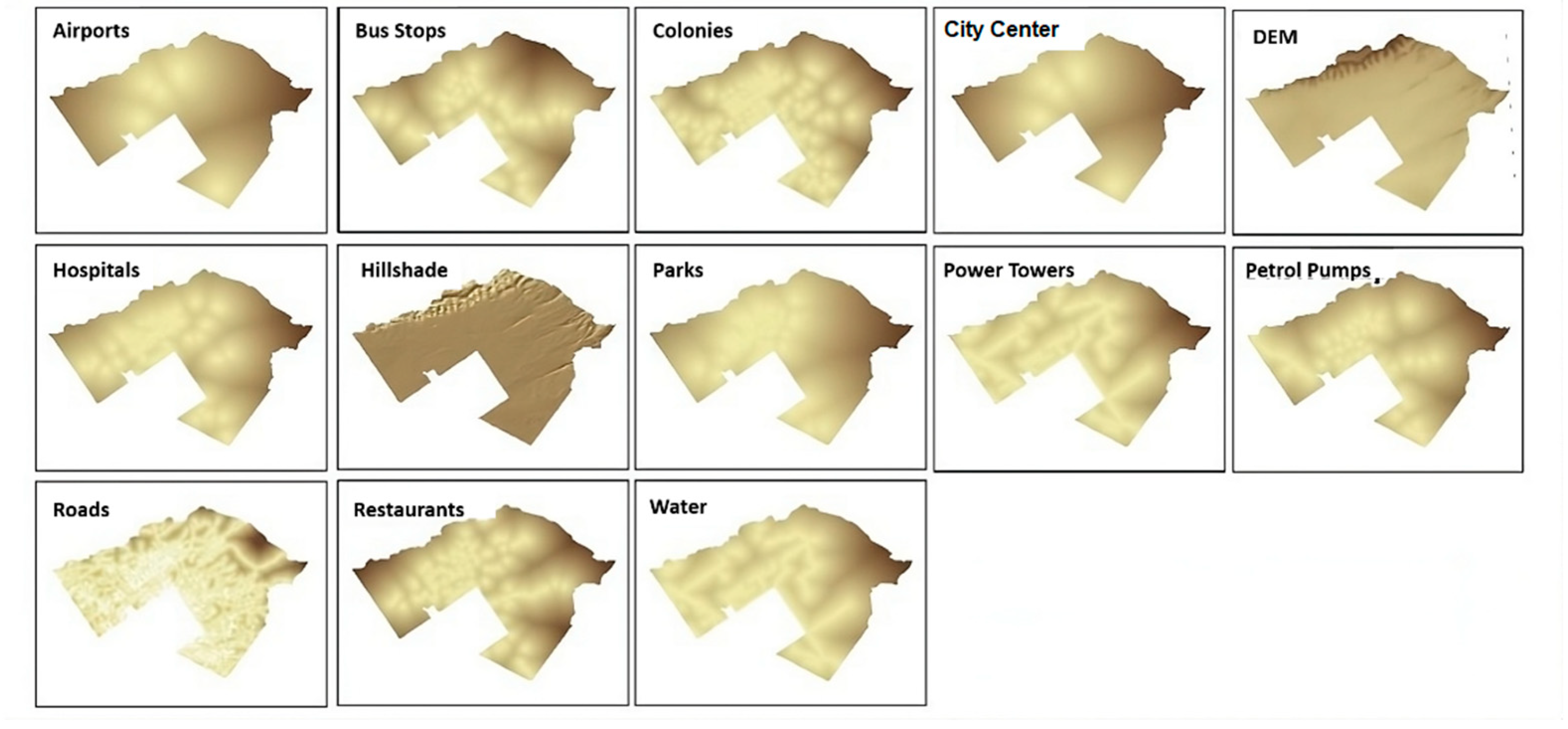


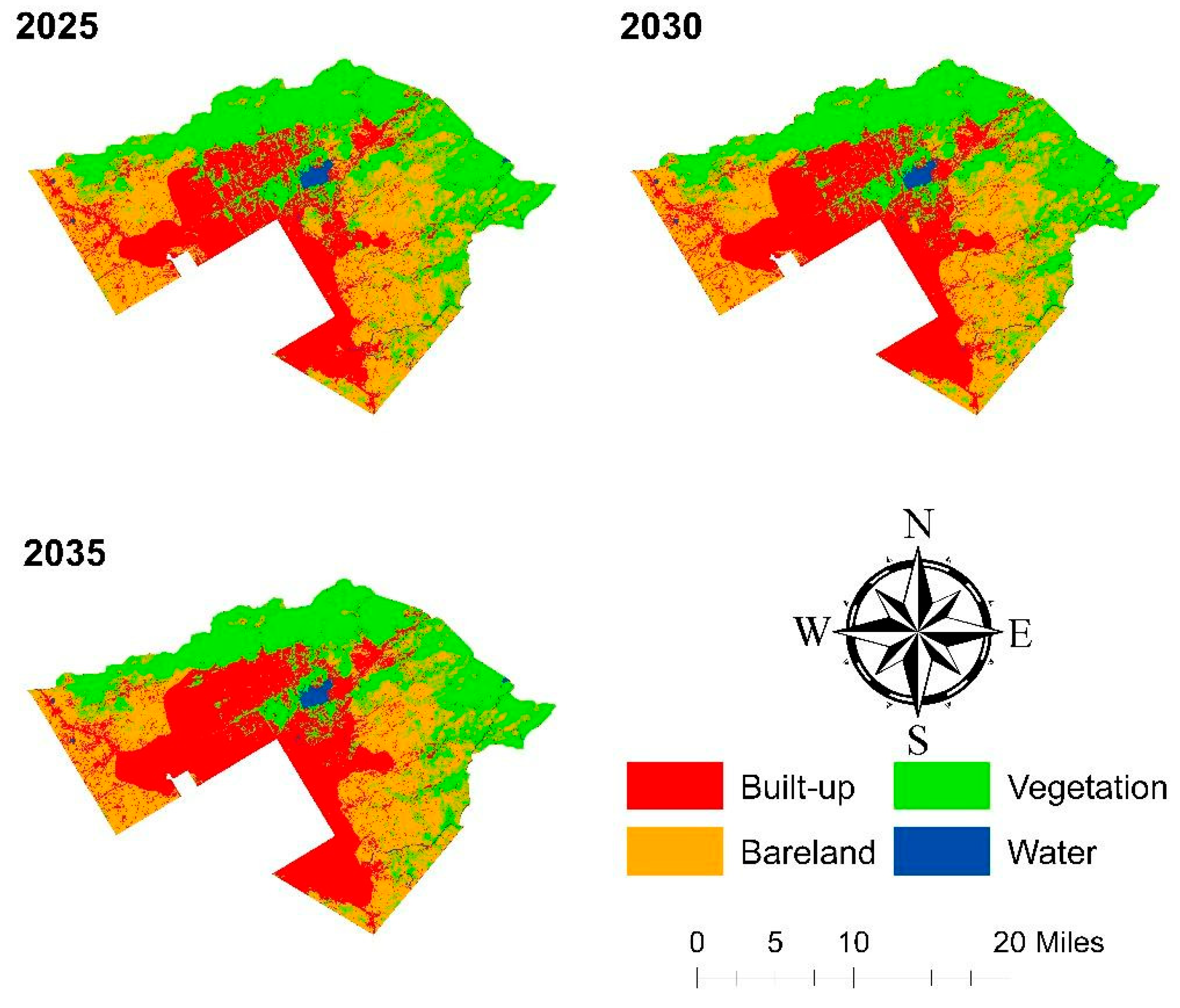


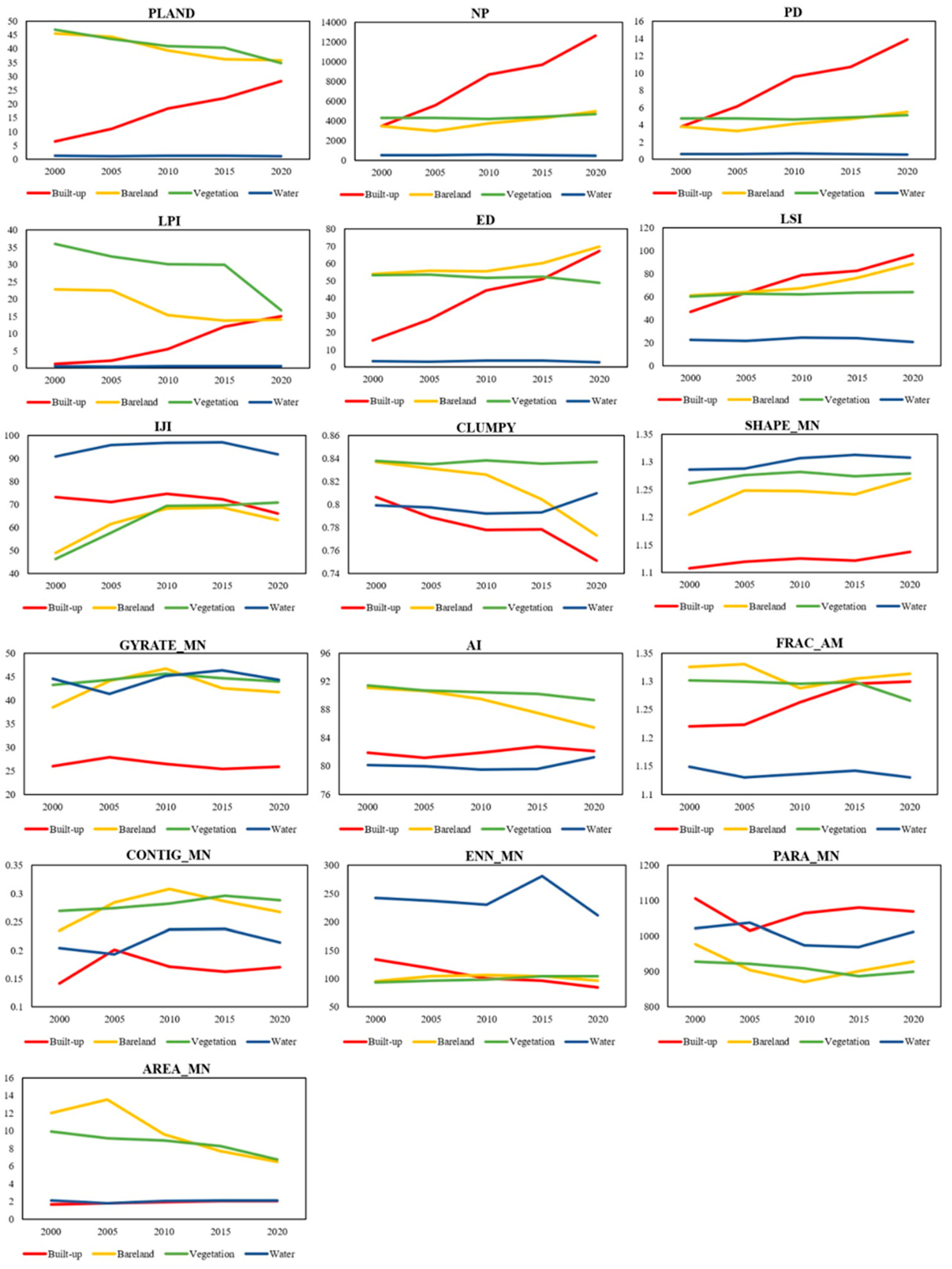
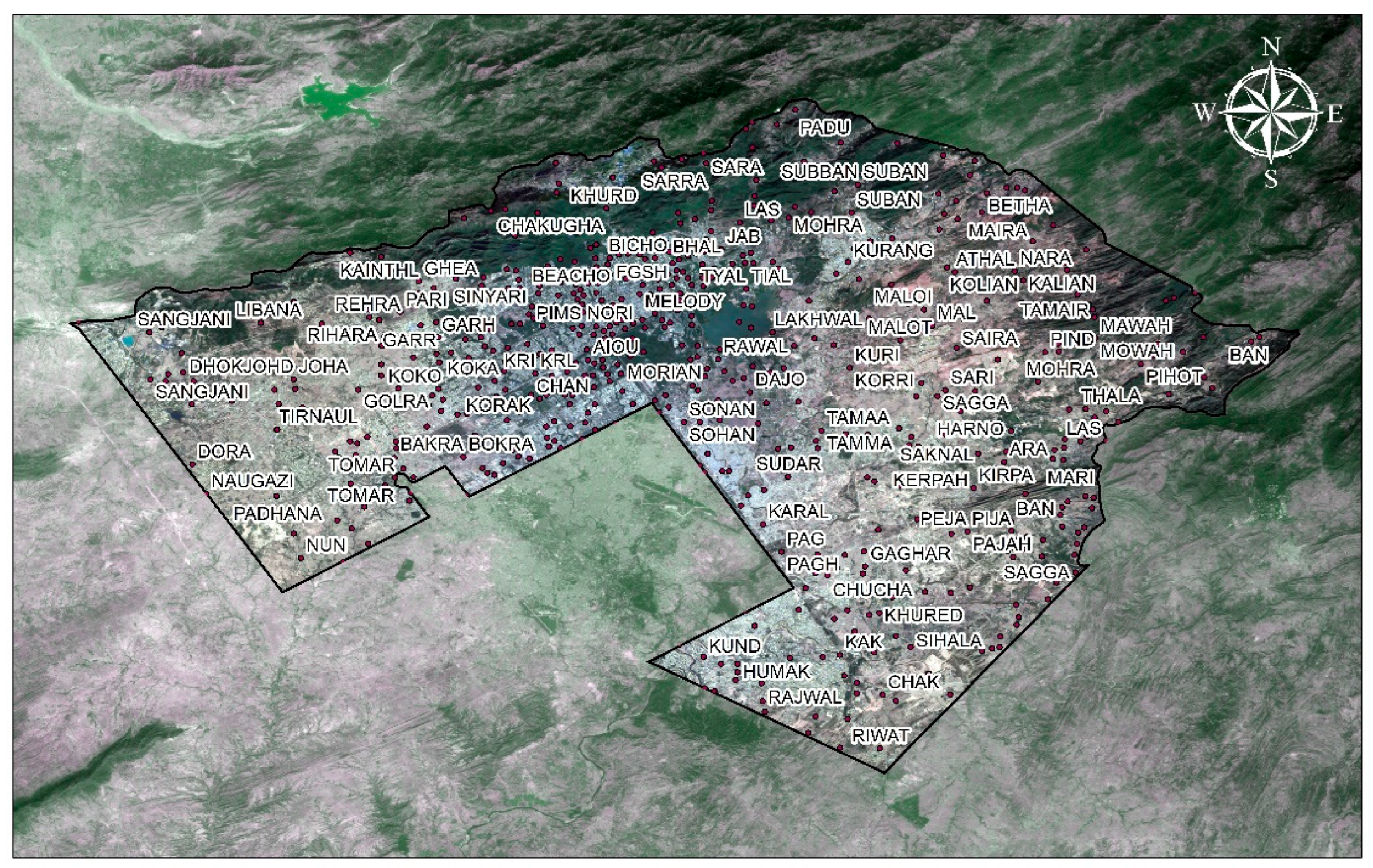
| Metrics | Metric Name | Acronym Unit | Description |
|---|---|---|---|
| Proximity | Mean Proximity Index (MPI) | m | A measure of a habitat class’s interconnectedness. Within a given search radius, the magnitude and similarity of every area with the same type of habitat are taken into account. |
| Mean Euclidean Nearest Neighbor Distance (ENN_MN) | m | The complexity of the shape enhances its shortest edge-to-edge interval between two patches of the same kind. It describes whether a landscape or habitat type is related or isolated. | |
| Diversity and Texture | Contagion (CONTAG) | % | Calculate the overall likelihood that a patch of cells that are adjacent to one another will be of the same type. |
| Shannon’s Diversity Index | None | Signify landscape diversity derived from the abundance of patch types. | |
| Shape and Edge | Density of Edges (ED) | m/ha | Calculate the total lengths of all patch-type edge segments that fit the unit area. The complexity of each patch form is demonstrated by the edge density. |
| Largest Patch Index (LPI) | % | The proportion of the overall landscape area to the biggest patch of that particular patch kind. | |
| Area Weighted Mean Fractal Dimension Index (AWMPFD | None | Divide the total patch area by the average dimensions of patches of a specific patch type. | |
| Mean Shape Index (MSI) | Meter per Square Kilometer (m/km2) | Measures the patch shape’s complexity in comparison to a regular shape of the same dimension. Its worth rises as the form become more complicated. | |
| Mean-Perimeter-to-Area Ratio (MPAR) | Meter per Square Kilometer (m/km2) | The perimeter-length-to-patch-area ratio determines the patch form complexity. It describes shape complexity without requiring a regular Euclidean shape to be used (square). | |
| Patch size and Density | Patch Density (PD) | Number of patches per 100 ha | The number of patches per unit area |
| Percentage of Landscape (PLAND) | % | The combined landscape area. | |
| Mean Patch Area (MPA) | ha | Each class’s average patch size | |
| Number of Patches (NP) | % | The cumulative number of patches in a given category’s landscape. | |
| Mean Patch Size (MPS) | Square Kilometer (km2) | The total area of all patches in the class is divided by the total number of patches in the class |
| LULC Class | Area (km2) | ||||
|---|---|---|---|---|---|
| Years | 2000 | 2005 | 2010 | 2015 | 2020 |
| Built-up | 58.09 | 100.01 | 166.95 | 201.33 | 256.49 |
| Bareland | 414.37 | 404.64 | 358.67 | 329.89 | 326.49 |
| Vegetation | 428.28 | 396.85 | 373.24 | 367.88 | 316.53 |
| Water | 11.05 | 9.71 | 11.98 | 11.45 | 10.76 |
| Total | 911.79 | 911.21 | 910.84 | 910.58 | 910.28 |
| 2000–2005 | Built-Up | Bareland | Vegetation | Water | Total/LSE | L | G | Change 2000–2005 (km2) | % of Change | Annual Rate of Change (%) |
|---|---|---|---|---|---|---|---|---|---|---|
| Built-up | 58.08 | 0.00 | 0.00 | 0.00 | 58.08 | 0.00 | 41.78 | 41.92 | 72.15 | 10.86 |
| Bareland | 32.04 | 379.48 | 0.00 | 1.85 | 413.37 | 33.89 | 24.60 | −9.72 | −2.34 | −0.47 |
| Vegetation | 8.84 | 21.81 | 396.73 | 0.53 | 427.91 | 31.18 | 0.00 | −31.43 | −7.33 | −1.52 |
| Water | 0.91 | 2.78 | 0.00 | 7.32 | 11.01 | 3.69 | 2.38 | −1.35 | −12.18 | −2.59 |
| Total/PSL | 99.86 | 404.08 | 396.73 | 9.70 | 910.37 | 68.76 | 68.76 | −0.58 | 50.28 | |
| 2005–2010 | ||||||||||
| Built-up | 99.98 | 0.00 | 0.00 | 0.00 | 99.98 | 0.00 | 66.76 | 66.94 | 66.93 | 10.24 |
| Bareland | 57.48 | 343.87 | 0.00 | 2.58 | 403.93 | 60.06 | 14.18 | −45.97 | −11.36 | −2.41 |
| Vegetation | 8.41 | 13.80 | 373.13 | 0.90 | 396.24 | 23.11 | 0 | −23.60 | −5.94 | −1.22 |
| Water | 0.87 | 0.38 | 0.00 | 8.45 | 9.70 | 1.25 | 3.47 | 2.27 | 23.40 | 4.20 |
| Total/PSL | 166.74 | 358.05 | 373.13 | 11.93 | 910.37 | 84.42 | 84.42 | −0.37 | 73.04 | |
| 2010–2015 | ||||||||||
| Built-up | 166.90 | 0.00 | 0.00 | 0.00 | 166.90 | 0.00 | 34.32 | 34.38 | 20.59 | 3.74 |
| Bareland | 23.78 | 285.73 | 47.59 | 0.98 | 358.08 | 72.35 | 43.60 | −28.77 | −8.02 | −1.67 |
| Vegetation | 9.95 | 42.70 | 318.34 | 1.31 | 372.31 | 53.97 | 48.87 | −5.35 | −1.43 | −0.28 |
| Water | 0.59 | 0.89 | 1.28 | 9.16 | 11.93 | 2.76 | 2.29 | −0.52 | −4.34 | −0.88 |
| Total/PSL | 201.23 | 329.33 | 367.22 | 11.45 | 910.37 | 129.08 | 129.08 | −0.26 | 6.80 | |
| 2015–2020 | ||||||||||
| Built-up | 201.28 | 0.00 | 0.00 | 0.00 | 201.28 | 0.00 | 55.81 | 55.15 | 27.39 | 4.84 |
| Bareland | 32.48 | 269.36 | 27.39 | 0.50 | 329.73 | 60.36 | 56.92 | −3.40 | −1.03 | −0.20 |
| Vegetation | 22.62 | 56.40 | 287.69 | 0.60 | 367.31 | 79.62 | 28.70 | −51.35 | −13.95 | −3.00 |
| Water | 0.72 | 0.51 | 1.31 | 8.91 | 11.45 | 2.54 | 1.10 | −0.69 | −6.06 | −1.25 |
| Total/PSL | 257.09 | 326.28 | 316.38 | 10.01 | 910.37 | 142.53 | 142.53 | −0.30 | 6.34 | |
| 2000–2020 | ||||||||||
| Built-up | 58.08 | 0.00 | 0.00 | 0.00 | 58.08 | 0.00 | 198.7 | 198.39 | 341.51 | 0.30 |
| Bareland | 130.89 | 250.40 | 30.56 | 1.58 | 413.44 | 163.04 | 75.65 | −87.87 | −21.20 | 0.21 |
| Vegetation | 64.79 | 75.14 | 285.28 | 1.47 | 426.67 | 141.39 | 31.08 | −111.74 | −26.09 | 0.21 |
| Water | 3.02 | 0.51 | 0.52 | 6.96 | 11.00 | 4.05 | 3.05 | −0.289 | −2.62 | 0.22 |
| Total/PSL | 256.77 | 326.05 | 316.36 | 10.01 | 910.37 | 308.48 | 308.4 | −1.51 | 291.59 | |
| Years | User Accuracy (%) | Producer Accuracy (%) | Overall Accuracy | Kappa Coefficient | ||||||
|---|---|---|---|---|---|---|---|---|---|---|
| Built-Up | Bareland | Vegetation | Water | Built-Up | Bareland | Vegetation | Water | |||
| 2000 | 92.00 | 93.33 | 89.74 | 83.33 | 95.83 | 87.50 | 92.11 | 83.33 | 91.00 | 0.8700 |
| 2005 | 95.65 | 93.10 | 89.74 | 88.89 | 91.67 | 93.10 | 92.11 | 88.89 | 92.00 | 0.8864 |
| 2010 | 96.43 | 88.00 | 89.74 | 100.00 | 90.00 | 84.62 | 97.22 | 100.00 | 92.03 | 0.8864 |
| 2015 | 93.33 | 89.66 | 94.44 | 100.00 | 93.33 | 89.66 | 97.14 | 83.33 | 93.00 | 0.8996 |
| 2020 | 93.75 | 89.66 | 96.67 | 88.89 | 90.91 | 96.30 | 90.63 | 100.00 | 93.00 | 0.9018 |
| Years | 2000 | 2005 | 2010 | 2015 | 2020 | |||||
|---|---|---|---|---|---|---|---|---|---|---|
| LULC Class | Area (km2) | % of Total | Area (km2) | % of Total | Area (km2) | % of Total | Area (km2) | % of Total | Area (km2) | % of Total |
| Built-up | 58.09 | 6.37 | 100.01 | 10.98 | 166.95 | 18.33 | 201.34 | 22.11 | 256.49 | 28.18 |
| Non-Built-up | 853.7 | 93.63 | 811.2 | 89.02 | 743.89 | 81.67 | 709.24 | 78.53 | 653.78 | 71.82 |
| Total | 910.00 | 6.37 | 910.00 | 10.98 | 910.00 | 18.33 | 910.00 | 100.00 | 910.00 | 28.18 |
| L | Tc | Nc | ANC | S | G | P | G/P | L/P | N/P | |
|---|---|---|---|---|---|---|---|---|---|---|
| Built-up | 0.00 | 198.70 | −198.70 | 198.70 | 0.00 | 198.70 | 58.08 | 3.421 | 0.000 | 3.421 |
| Bareland | 163.04 | 238.68 | 87.39 | 87.39 | 151.30 | 75.65 | 250.40 | 0.302 | 0.651 | 0.349 |
| Vegetation | 141.39 | 172.47 | 110.31 | 110.31 | 62.16 | 31.08 | 285.28 | 0.109 | 0.496 | 0.387 |
| Water | 4.05 | 7.10 | 1.00 | 1.00 | 6.10 | 3.05 | 6.96 | 0.439 | 0.582 | 0.143 |
| Driving Factor | Cramer’s V |
|---|---|
| Colonies | 0.2924 |
| DEM | 0.2684 |
| Airports | 0.2647 |
| Bus Stops | 0.2628 |
| Hospitals | 0.2432 |
| Roads | 0.2202 |
| Water Courses | 0.2168 |
| Restaurants | 0.2125 |
| Hillshade | 0.2074 |
| Parks | 0.2039 |
| Power Towers | 0.2032 |
| City Centers | 0.1932 |
| Petrol Pumps | 0.1794 |
| Classes | Area (km2) | |
|---|---|---|
| Actual | Predicted | |
| Built-up | 256.49 | 232.90 |
| Bareland | 326.49 | 307.51 |
| Vegetation | 316.53 | 358.73 |
| Water | 10.76 | 10.89 |
| Total | 910.28 | 910.03 |
| LULC | Area (km2) | Change Rate (%) | ||||||
|---|---|---|---|---|---|---|---|---|
| Years | 2020 | 2025 | 2030 | 2035 | 2020–2025 | 2020–2030 | 2020–2035 | 2000–2035 |
| Built-up | 256.49 | 263.34 | 293.47 | 319.57 | 2.67 | 14.42 | 24.59 | 45.10 |
| Bareland | 326.49 | 290.11 | 272.56 | 258.09 | −11.14 | −16.51 | −20.94 | −37.71 |
| Vegetation | 316.53 | 346.19 | 334.10 | 322.93 | −9.37 | −5.55 | −2.02 | −24.59 |
| Water | 10.76 | 10.36 | 9.87 | 9.41 | −3.73 | −8.30 | −12.56 | −14.85 |
| Annual Rate of Change (%) | Change in Area (km2) | |||||
|---|---|---|---|---|---|---|
| 2020–2025 | 2025–2030 | 2030–2035 | 2020–2035 | 2020–2025 | 2020–2030 | 2020–2035 |
| 0.53 | 2.17 | 1.70 | 7.47 | 6.85 | 36.98 | 63.08 |
| −2.36 | −1.25 | −1.09 | −1.57 | −36.37 | −53.92 | −68.39 |
| 1.79 | −0.71 | −0.68 | 0.13 | 29.66 | 17.57 | 6.40 |
| −0.76 | −0.97 | −0.95 | −0.90 | −0.40 | −0.89 | −1.35 |
| Classes | Gain | Loss | Net Contribution | |||
|---|---|---|---|---|---|---|
| Built-Up | Bareland | Vegetation | Water | |||
| Built-up | 112.51 | 0.00 | 0.00 | −77.06 | −33.81 | −1.65 |
| Bareland | 25.63 | −123.78 | 77.06 | 0.00 | 21.35 | −0.26 |
| Vegetation | 47.12 | −60.05 | 33.81 | −21.35 | 0.00 | 0.48 |
| Water | 1.54 | −2.97 | 1.65 | 0.26 | −0.48 | 0.00 |
Disclaimer/Publisher’s Note: The statements, opinions and data contained in all publications are solely those of the individual author(s) and contributor(s) and not of MDPI and/or the editor(s). MDPI and/or the editor(s) disclaim responsibility for any injury to people or property resulting from any ideas, methods, instructions or products referred to in the content. |
© 2025 by the authors. Licensee MDPI, Basel, Switzerland. This article is an open access article distributed under the terms and conditions of the Creative Commons Attribution (CC BY) license (https://creativecommons.org/licenses/by/4.0/).
Share and Cite
Sarwar, S.; Khan, H.U.A.; Wu, F.; Hasan, S.; Zohaib, M.; Abbasi, M.; Hu, T. Forecasting Urban Sprawl Dynamics in Islamabad: A Neural Network Approach. Remote Sens. 2025, 17, 492. https://doi.org/10.3390/rs17030492
Sarwar S, Khan HUA, Wu F, Hasan S, Zohaib M, Abbasi M, Hu T. Forecasting Urban Sprawl Dynamics in Islamabad: A Neural Network Approach. Remote Sensing. 2025; 17(3):492. https://doi.org/10.3390/rs17030492
Chicago/Turabian StyleSarwar, Saddam, Hafiz Usman Ahmed Khan, Falin Wu, Sarah Hasan, Muhammad Zohaib, Mahzabin Abbasi, and Tianyang Hu. 2025. "Forecasting Urban Sprawl Dynamics in Islamabad: A Neural Network Approach" Remote Sensing 17, no. 3: 492. https://doi.org/10.3390/rs17030492
APA StyleSarwar, S., Khan, H. U. A., Wu, F., Hasan, S., Zohaib, M., Abbasi, M., & Hu, T. (2025). Forecasting Urban Sprawl Dynamics in Islamabad: A Neural Network Approach. Remote Sensing, 17(3), 492. https://doi.org/10.3390/rs17030492






